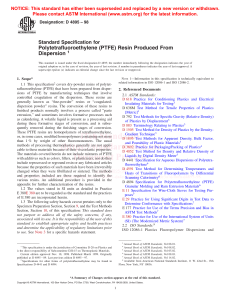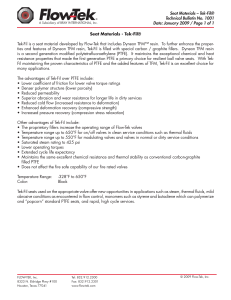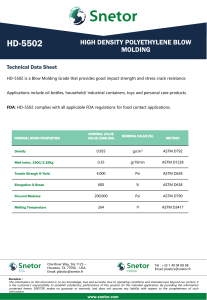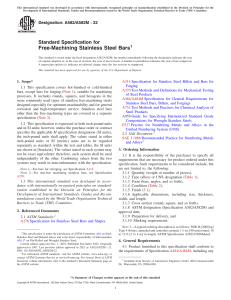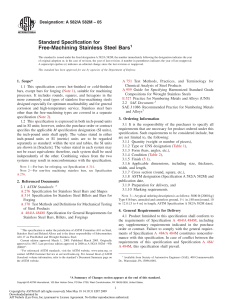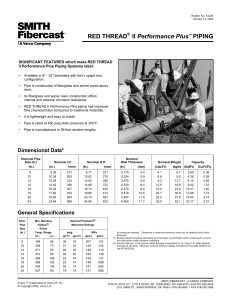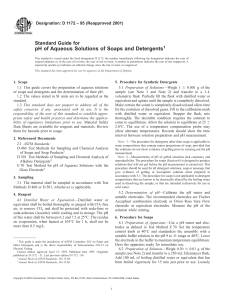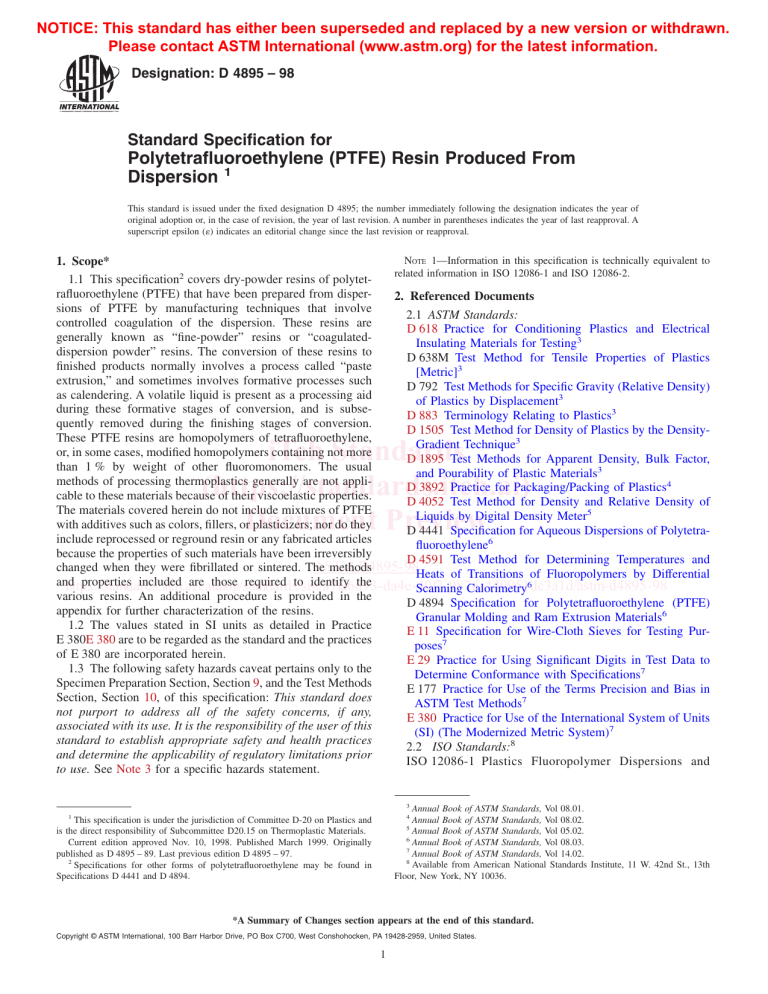
NOTICE: This standard has either been superseded and replaced by a new version or withdrawn. Please contact ASTM International (www.astm.org) for the latest information. Designation: D 4895 – 98 Standard Specification for Polytetrafluoroethylene (PTFE) Resin Produced From Dispersion 1 This standard is issued under the fixed designation D 4895; the number immediately following the designation indicates the year of original adoption or, in the case of revision, the year of last revision. A number in parentheses indicates the year of last reapproval. A superscript epsilon (´) indicates an editorial change since the last revision or reapproval. NOTE 1—Information in this specification is technically equivalent to 1. Scope* related information in ISO 12086-1 and ISO 12086-2. 2 1.1 This specification covers dry-powder resins of polytetrafluoroethylene (PTFE) that have been prepared from disper2. Referenced Documents sions of PTFE by manufacturing techniques that involve 2.1 ASTM Standards: controlled coagulation of the dispersion. These resins are D 618 Practice for Conditioning Plastics and Electrical generally known as “fine-powder” resins or “coagulatedInsulating Materials for Testing3 dispersion powder” resins. The conversion of these resins to D 638M Test Method for Tensile Properties of Plastics finished products normally involves a process called “paste [Metric]3 extrusion,” and sometimes involves formative processes such D 792 Test Methods for Specific Gravity (Relative Density) as calendering. A volatile liquid is present as a processing aid of Plastics by Displacement3 during these formative stages of conversion, and is subseD 883 Terminology Relating to Plastics3 quently removed during the finishing stages of conversion. D 1505 Test Method for Density of Plastics by the DensityThese PTFE resins are homopolymers of tetrafluoroethylene, Gradient Technique3 or, in some cases, modified homopolymers containing not more D 1895 Test Methods for Apparent Density, Bulk Factor, than 1 % by weight of other fluoromonomers. The usual and Pourability of Plastic Materials3 methods of processing thermoplastics generally are not appliD 3892 Practice for Packaging/Packing of Plastics4 cable to these materials because of their viscoelastic properties. D 4052 Test Method for Density and Relative Density of The materials covered herein do not include mixtures of PTFE Liquids by Digital Density Meter5 with additives such as colors, fillers, or plasticizers; nor do they D 4441 Specification for Aqueous Dispersions of Polytetrainclude reprocessed or reground resin or any fabricated articles fluoroethylene6 because the properties of such materials have been irreversibly D 4591 Test Method for Determining Temperatures and ASTM D4895-98Heats of Transitions of Fluoropolymers by Differential changed when they were fibrillated or sintered. The methods and properties included are those required to identify the https://standards.iteh.ai/catalog/standards/sist/a7fa6d93-da4e-40f2-9876-440951dc3a1d/astm-d4895-98 Scanning Calorimetry6 various resins. An additional procedure is provided in the D 4894 Specification for Polytetrafluoroethylene (PTFE) appendix for further characterization of the resins. Granular Molding and Ram Extrusion Materials6 1.2 The values stated in SI units as detailed in Practice E 11 Specification for Wire-Cloth Sieves for Testing PurE 380E 380 are to be regarded as the standard and the practices poses7 of E 380 are incorporated herein. E 29 Practice for Using Significant Digits in Test Data to 1.3 The following safety hazards caveat pertains only to the Determine Conformance with Specifications7 Specimen Preparation Section, Section 9, and the Test Methods E 177 Practice for Use of the Terms Precision and Bias in Section, Section 10, of this specification: This standard does ASTM Test Methods7 not purport to address all of the safety concerns, if any, E 380 Practice for Use of the International System of Units associated with its use. It is the responsibility of the user of this (SI) (The Modernized Metric System)7 standard to establish appropriate safety and health practices 2.2 ISO Standards:8 and determine the applicability of regulatory limitations prior ISO 12086-1 Plastics Fluoropolymer Dispersions and to use. See Note 3 for a specific hazards statement. iTeh Standards (https://standards.iteh.ai) Document Preview 3 Annual Book of ASTM Standards, Vol 08.01. Annual Book of ASTM Standards, Vol 08.02. 5 Annual Book of ASTM Standards, Vol 05.02. 6 Annual Book of ASTM Standards, Vol 08.03. 7 Annual Book of ASTM Standards, Vol 14.02. 8 Available from American National Standards Institute, 11 W. 42nd St., 13th Floor, New York, NY 10036. 4 1 This specification is under the jurisdiction of Committee D-20 on Plastics and is the direct responsibility of Subcommittee D20.15 on Thermoplastic Materials. Current edition approved Nov. 10, 1998. Published March 1999. Originally published as D 4895 – 89. Last previous edition D 4895 – 97. 2 Specifications for other forms of polytetrafluoroethylene may be found in Specifications D 4441 and D 4894. *A Summary of Changes section appears at the end of this standard. Copyright © ASTM International, 100 Barr Harbor Drive, PO Box C700, West Conshohocken, PA 19428-2959, United States. 1 NOTICE: This standard has either been superseded and replaced by a new version or withdrawn. Please contact ASTM International (www.astm.org) for the latest information. D 4895 – 98 4. Classification Molding and Extrusion Materials—Part 1: Designation and Specification ISO 12086-2 Plastics Fluoropolymer Dispersions and Molding and Extrusion Materials—Part 2: Preparation of Test Specimens and Determination of Properties 4.1 This specification covers the following types of PTFE: 4.1.1 Type I and Type II—Resin produced from dispersion and normally used with a volatile processing aid. These resins all have the same requirements for bulk density, particle size, water content, melting peak temperature, tensile, and elongation. These resins are divided into four grades according to standard specific gravity (SSG), Thermal Stability Index (TII), and Stretching Void Index (SVI). Grades are divided into classes according to extrusion pressure. 3. Terminology 3.1 Definitions—The definitions given in Terminology D 883D 883 are applicable to this specification. 3.2 Descriptions of Terms Specific to This Standard: 3.2.1 bulk density, n—the mass in grams per litre of resin NOTE 2—See Tables 1 and 2 for details about grades and classes. measured under the conditions of the test. 3.2.2 extended specific gravity (ESG), n—the specific grav4.2 A one-line system may be used to specify materials ity of a specimen of PTFE material molded as described in this covered by this specification. The system uses predefined cells specification and sintered (see 3.2.7) for an extended period of to refer to specific aspects of this specification, as illustrated as time, compared to the sintering time for the measurement of follows: SSG (see 3.2.8), using the appropriate sintering schedule given in this specification. 3.2.3 lot, n—one production run or a uniform blend of two Specification or more production runs. 3.2.4 preforming, vb—compacting powdered PTFE mateStandard Number Type Grade Class Special Notes rial under pressure in a mold to produce a solid object, called Block a preform, that is capable of being handled. Molding and | | | | | compaction are terms used interchangeably with preforming Example: Specification I 2 C for PTFE. D 4895 3.2.5 reground resin, n—resin produced by grinding PTFE material that has been preformed but has never been sintered. 3.2.6 reprocessed resin, n—resin produced by grinding For this example, the line callout would be Specification D PTFE material that has been preformed and sintered. 4895 , I2C, and would specify a coagulated dispersion 3.2.7 sintering, n—as it applies to PTFE, a thermal treatform of polytetrafluoroethylene that has all of the properties ment during which the PTFE is melted and recrystallized by listed for that type, grade, and class in the appropriate specified cooling with coalescence occurring during the treatment. properties or tables, or both, in the specification identified. A 3.2.8 standard specific gravity (SSG), n—the specific gravcomma is used as the separator between the standard number ity of a specimen of PTFE material molded as described in this and the type. Separators are not needed between the type, ASTM D4895-98 specification and sintered using the appropriate sintering grade, and class.9 Provision for Special Notes is included so https://standards.iteh.ai/catalog/standards/sist/a7fa6d93-da4e-40f2-9876-440951dc3a1d/astm-d4895-98 schedule given in this specification. that other information can be provided when required. An 3.2.9 strained specific gravity (strained SG), n—the specific example would be in Specification D 3295 where dimensions gravity of a specimen of PTFE material molded, sintered, and and tolerances are specified for each American Wire Gage strained as described in this specification. (AWG) size within type and class. When special notes are used, 3.2.10 stretching void index (SVI), n—a measure of the they should be preceded by a comma. change in specific gravity of PTFE material which has been subjected to tensile strain as described in this specification. 5. Mechanical Properties 3.2.11 thermal instability index (TII), n—a measure of the 5.1 The resins covered by this specification shall be in decrease in molecular weight of PTFE material which has been accordance with the requirements prescribed in Tables 1 and 2, heated for a prolonged period of time. when tested by the procedures specified herein. 3.2.12 unstrained specific gravity (USG), n—the specific gravity, prior to straining, of a specimen of PTFE material used in the Stretching Void Index Test (see 10.9) of this specifica9 tion. See the ASTM Form and Style Manual, available from ASTM Headquarters. iTeh Standards (https://standards.iteh.ai) Document Preview TABLE 1 Detail Requirements for all Types,A Grades and Classes A B Type Bulk Density, g/L Particle Size Average Diameter, µm Water Content, max, % I II 550 6 150 550 6 150 500 6 200 1050 6 350 0.04 0.04 Melting Peak Temperature, °C Initial Second B 327 6 10 327 6 10 B The types, grades, and classes are not the same as those in previous editions of Specification D 4895. Greater than 5.0°C above the second melting peak temperature. 2 Tensile Strength, min, MPa Elongation at Break, min, % 19 19 200 200 NOTICE: This standard has either been superseded and replaced by a new version or withdrawn. Please contact ASTM International (www.astm.org) for the latest information. D 4895 – 98 TABLE 2 Detail Requirements for All Types,A Grades and Classes Standard Specific Gravity Type I Grade 1 2 3 II 4 1 Class A B C A B C C D E B A min max 2.14 2.14 2.14 2.17 2.17 2.17 2.15 2.15 2.15 2.14 2.14 2.18 2.18 2.18 2.25 2.25 2.25 2.19 2.19 2.19 2.16 2.25 Extrusion Pressure, MPa Thermal Instability Index, max Stretching Void Index, max 5 to <15B 15 to <55D 15 to <75E 5 to <15B 15 to <55D 15 to <75E 15 to <75E 15 to <65E 15 to <65E 15 to <55D 5 to <15B 50 50 50 50 50 50 15 15 50 15 50 NAC NAC NAC NAC NAC NAC 200 100 200 50 NAC A The types, grades, and classes are not the same as those in previous editions of Specification D 4895. Tested at a reduction ratio of 100:1 (reduction ratio is the ratio of the cross-sectional area of the preform to the cross-sectional area of the die). Not applicable. D Tested at a reduction ratio of 400:1. E Tested at a reduction ratio of 1600:1. B C both sides of the resin. The test resin should be near ambient temperature prior to molding (see Note 4). 6. Other Requirements 6.1 The resin shall be uniform and shall contain no additives or foreign material. 6.2 The color of the material as shipped by the supplier shall be natural white. 6.3 For purposes of determining conformance, all specified limits for this classification system are absolute limits, as defined in Practice E 29E 29. 6.3.1 With the absolute method, an observed value is not rounded, but is to be compared directly with the limiting value. Example: In Table 1 Type 4, Class B, under Specific Gravity, 2.14 should be considered as 2.140000 and 2.16 should be considered 2.160000. NOTE 3—Caution: PTFE resins can evolve small quantities of gaseous products when heated above 204°C (400°F). Some of these gases are harmful. Consequently, exhaust ventilation must be used whenever these resins are heated above this temperature, as they are during the sintering operations that are a part of this specification. Since the temperature of burning tobacco exceeds 204°C (400°F), those working with PTFE resins should ensure that tobacco is not contaminated. NOTE 4—For maximum precision, these weighing and preforming operations should be carried out at 23 6 2°C (73.4 6 3.6°F) (the “near ambient” temperature referred to herein). These operations should not be performed at temperatures below about 21°C (70°F) due to the crystalline transition that occurs in PTFE in this temperature region which leads to possible cracks in sintered specimens and differences in specimen density (as well as changes in other physical properties). Problems caused by the 7. Sampling effect of temperature on the specific gravity or density of PTFE can be 7.1 The resin shall be sampled in accordance with an minimized when the measurement is made using immersion procedures if ASTM D4895-98 adequate statistical sampling program. Adequate statistical a sensitive thermometer (for example, one reading 6 0.1°C) is used in the https://standards.iteh.ai/catalog/standards/sist/a7fa6d93-da4e-40f2-9876-440951dc3a1d/astm-d4895-98 sampling prior to packaging shall be considered an acceptable liquid and the temperature is adjusted to be at least 22°C. iTeh Standards (https://standards.iteh.ai) Document Preview alternative. 7.2 The producer shall take (and test) sufficient within-lot samples to ensure adequate in-process quality control and continuing conformance to the property requirements of this specification. 9.1.2 Screen 14.5 g of PTFE resin through a No. 10 sieve into the die. Adjust the lower plug height so that the resin in the die can be leveled by drawing a straightedge in contact with the top of the die across the top of the die cavity. Insert the die in a suitable hydraulic press and apply pressure gradually (see Note 5) until a pressure of 14 MPa (2030 psi) is attained. Hold this pressure for 3 min. Remove the disk from the die. A wax pencil may be used to write the sample identification on the disk at this time. 8. Number of Tests 8.1 Lot inspection shall include tests for bulk density, particle size, and extrusion pressure. Periodic tests shall consist of all the tests specified in Tables 1 and 2 and shall be made at least once per year. 8.2 The tests listed in Tables 1 and 2, as they apply, are sufficient to establish conformity of a material to this specification. One set of test specimens as prescribed in Section 3 shall be considered sufficient for testing each sample. The average of the results for the specimens tested shall conform to the requirements of this specification. NOTE 5—As a guide, increasing the pressure at a rate of 3.5 MPa (500 psi)/min is suggested until the desired maximum pressure is attained. 9.1.3 Place the sintering oven in a laboratory hood (or equip it with an adequate exhaust system) and sinter the preforms in accordance with Table 3, Procedure A (see Note 6). NOTE 6—Although the rate of heat application is not critical, the cooling cycle is most important and the conditions cited in this procedure must be followed very closely. If they are not followed, the crystallinity of the disks and the resulting physical properties may be markedly changed. Therefore, the use of a programmed oven is recommended for the most precise sintering cycle control so that the hood window may be left down during the entire sintering procedure, the latter being an important safety consideration. 9. Specimen Preparation 9.1 Test Disks for Tensile Properties: 9.1.1 Use the die shown in Fig. 1 for the molding of test disks (see Note 2). Place flat aluminum disks, 0.1 to 0.4 mm (0.004 in. to 0.016 in.) thick and 76 mm (3 in.) in diameter, on 3 NOTICE: This standard has either been superseded and replaced by a new version or withdrawn. Please contact ASTM International (www.astm.org) for the latest information. D 4895 – 98 iTeh Standards (https://standards.iteh.ai) brate to near ambient temperature. Then screen and weigh the Document Preview 12.0 6 0.1-g sample. Insert the die in a suitable hydraulic press NOTE—All dimensions are in millimetres. FIG. 1 Mold Assembly for the Preparation of Specimens for the Determination of Tensile Properties TABLE 3 Sintering Procedures A B and apply pressure gradually (see Note 5) until a pressure of 14 MPa ASTM D4895-98 (2030 psi) is attained. Hold this pressure for 2 min. Remove the preform from the die. A wax pencil may be used Hold temperature, °C (°F) https://standards.iteh.ai/catalog/standards/sist/a7fa6d93-da4e-40f2-9876-440951dc3a1d/astm-d4895-98 to write the sample identification on the preform at this time. Hold time, min 9.2.3 Sinter the preforms in accordance with Table 3 (see Cooling rate, °C/h (°F/h) Note 6). 9.2.3.1 For SSG specimens use Procedure A. Second hold temperature, °C (°F) 9.2.3.2 For ESG specimens use Procedure B. Initial temperature, °C (°F) Rate of heating, °C/h (°F/h) Second hold time, min Period to room temperature, min 290 (554) 120 6 10 (216 6 18) 380 6 6 (716 6 10) 30 + 2, −0 60 6 5 (108 6 9) 294 6 6 (561 6 10) 24 + 0.5, −0 $30 290 (554) 120 6 10 (216 6 18) 380 6 6 (716 6 10) 360 6 5 60 6 5 (108 6 9) 294 6 6 (561 6 10) 24 + 0.5, −0 $30 NOTE 7—Improved precision in SSG and ESG test results has been obtained with the use of an upright, cylindrical oven and an aluminum sintering rack. The cylindrical oven has an inside diameter of 140 mm (5.5 in.) and an inside depth of 203 mm (8 in.) plus additional depth to accommodate a 51-mm (2-in.) thick cover, and is equipped with suitable heaters and controllers to sinter specimens in accordance with the procedures in Table 3. The rack, as shown in Fig. 2, allows preforms to be placed symmetrically in the center region of the oven. Place six preforms on each of the middle oven rack shelves (if six or fewer preforms are to be sintered, place them on the middle rack, filling in with “dummies” as needed). Place “dummies” on the top and bottom shelves. Specimens must be spaced evenly in a circle on each shelf, with none of them touching. An oven load must be no less than 18 pieces including “dummies.” “Dummies” are defined as normal 12-g specimens that have previously been through the sintering cycle. “Dummies” must only be used for an additional two or three thermal cycles, due to eventual loss of thermal stability and physical form. 9.2 Test Specimens for Standard Specific Gravity and Thermal Instability Index: 9.2.1 A cylindrical preforming mold, 29-mm (1.14-in.) internal diameter by at least 76 mm (3 in.) deep, is used to prepare the preforms. Clearance should be sufficient to ensure escape of air during pressing. Place flat aluminum foil disks, normally 0.13 mm (0.005 in.) thick and 29 mm (1.14 in.) in diameter on both sides of the resin. The test resin should be near ambient temperature prior to molding (see Note 4). 9.2.2 Weigh out 12.0 6 0.1 g of resin and place it in the die. Screen non-freeflowing resins through a No. 10 sieve. Compacted resins can be broken up by hand-shaking cold resin in a half-filled sealed glass container. Condition the resin in the sealed glass container in a freezer or dry-ice chest. After breaking up resin lumps, allow the sealed container to equili- 9.2.4 Remove all flash from each specimen so that no air bubbles will cling to the edges when the specimen is immersed in the solution for weighing during the standard specific gravity 4 NOTICE: This standard has either been superseded and replaced by a new version or withdrawn. Please contact ASTM International (www.astm.org) for the latest information. D 4895 – 98 (73.4 6 3.6°F), and (3) there shall be no requirement respecting humidity. The other tests require no conditioning of the molded test specimens. 9.5 Test Conditions: 9.5.1 Tests shall be conducted at the standard laboratory temperature of 23 6 2°C (73.4 6 3.6°F), unless otherwise specified in the test methods or in this specification. This deviation from the standard laboratory temperature is made because of the necessity for maintaining test temperatures above approximately 21°C (70°F). See Note 4 for additional details. Since these resins do not absorb water, the maintenance of constant humidity during testing is not required. 10. Test Methods 10.1 Melting Characteristics by Thermal Analysis: 10.1.1 Significance and Use—For PTFE resins that have been melted prior to use, the melting peak temperature characteristics of a resin provide important information about the thermal history of the material. Melting peak temperatures (see Fig. 3) are used to determine conformance of a resin to the melting peak temperature requirements in Table 1 of this specification. 10.1.2 Apparatus—Use apparatus described in Test Method D 4591D 4591. 10.1.3 Procedure—Measure melting peak temperatures in NOTE 1—Aluminum plates tack welded to rods. accordance with procedures given in Test Method NOTE 2—All dimensions are in millimetres. D 4591D 4591. An initial melting peak temperature above the FIG. 2 Sintering Rack for SSG Specimens melting peak temperature obtained on the second and subsequent melting (defined as the second melting peak temperature) indicates that the resin was not melted before the test. The and thermal instability index tests. It is recommended for this second melting peak temperature occurs at about 327°C section and during testing that cotton gloves be worn while (621°F). The difference between the initial and second melting handling test specimens. peak temperatures is greater than 5°C (9°F). If peak tempera9.3 Test Disks for Stretching Void Index (SVI): tures are difficult to discern from the curves (that is, because ASTM D4895-98 9.3.1 Mold the disk as in 9.1.1. the peaks are rounded rather than pointed) straight lines should https://standards.iteh.ai/catalog/standards/sist/a7fa6d93-da4e-40f2-9876-440951dc3a1d/astm-d4895-98 9.3.2 Screen 29 g of PTFE resin through a 2.00-mm (No. be drawn tangent to the sides of the peak. Where these lines 10) sieve into the die. Adjust the lower plug so that the resin intersect should be taken as the peak temperature. Multiple can be leveled by drawing a straightedge in contact with the top peaks during the initial melting test may occur. Where more of the die across the top of the die cavity. Insert the die in a than one peak occurs during the initial melting test, the suitable hydraulic press and apply pressure gradually (see Note 5) until a pressure of 7 MPa (1015 psi) is attained. Hold this pressure for 2 min, then increase the pressure to 14 MPa (2030 psi) and hold for an additional 2 min. Remove the disk from the die. A wax pencil may be used to write the sample identification on the disk at this time. 9.3.3 Sinter the preforms in accordance with Table 3, Procedure A (see Note 6). 9.3.4 Remove all flash from those portions of these specimens that will be used for determination of specific gravities so that no air bubbles will cling to their edges when the specimens are immersed in liquid during these tests. It is recommended that cotton gloves be worn while handling test specimens. 9.4 Conditioning Test Specimens: 9.4.1 For tests of tensile properties and all tests requiring the measurement of specific gravities, condition the test specimens in general accordance with Procedure A of Practice D 618D 618, with the following deviations therefrom: (1) the aging period shall be a minimum of 4 h immediately prior to testing, (2) the laboratory temperature shall be 23 6 2°C FIG. 3 Melting Characteristics by Thermal Analysis iTeh Standards (https://standards.iteh.ai) Document Preview 5 NOTICE: This standard has either been superseded and replaced by a new version or withdrawn. Please contact ASTM International (www.astm.org) for the latest information. D 4895 – 98 presence of any peak corresponding to the second melting peak temperature may indicate the presence of some previously melted material. 10.2 Bulk Density: 10.2.1 Significance and Use—Bulk density gives an indication of how a resin may perform during the filling of processing equipment. PTFE resins tend to compact during shipment and storage, and even though the material may be broken up by screening or some other means, original “as produced” results may not be duplicated. Because of this tendency to pack under small amounts of compression or shear, Test Method D 1895D 1895 is not applicable to these resins. The procedure given in 10.2.2 through 10.2.5 must be used to measure this property. 10.2.2 Apparatus: 10.2.2.1 Funnel—A funnel arrangement as shown in Fig. 4. 10.2.2.2 Feeder 10 —A feeder with a No. 8 wire screen placed over approximately the top two thirds of the trough. The funnel shall be mounted permanently in the feeder outlet. 10.2.2.3 Controller .11 10.2.2.4 Volumetric Cup and Cup Stand (see Fig. 5)—The volumetric cup shall be calibrated initially to 250 mL by filling it with distilled water, placing a planar glass plate on top, drying the outside of the cup, and weighing. The net weight shall be 250 6 0.5 g. The top and bottom faces of the volumetric cup and the cup stand shall be machined plane and parallel. 10.2.2.5 Leveling Device—The leveler (see Fig. 6) shall be affixed permanently to the table and adjusted so that the sawtooth edge of the leveler blade passes within 0.8 mm (0.031 in.) of the top of the volumetric cup. 10.2.2.6 Work Surface—The work surface for holding the volumetric cup and leveler shall be essentially free from vibration. The feeder, therefore, must be mounted on an adjoining table or wall bracket. 10.2.2.7 Balance—Balance, having an extended beam, with a capacity of 500 g and a sensitivity of 0.1 g, or equivalent. 10.2.3 Procedure—Place the clean, dry volumetric cup on the extended beam of the balance and adjust the tare to zero. Select about 500 mL of the resin to be tested and place it on the feeder screen. Put the cup in the cup stand and place the assembly such that the distance of free-polymer fall from the feeder outlet to the top rim of the cup shall be 39 6 3 mm (1.5 6 0.012 in.). Increased fall causes packing in the cup and higher bulk density values. Set the controller so that the cup is 10 A “Vibra-Flow” Feeder, Type FT01A, available from FMC Corp., Material Handling Division, FMC Building, Homer City, PA 15748, has been found satisfactory for this purpose. 11 A “Syntron” controller, Type SCR1B, available from FMC Corp., address as shown in Footnote 10, has been found satisfactory for this purpose. iTeh Standards (https://standards.iteh.ai) Document Preview ASTM D4895-98 https://standards.iteh.ai/catalog/standards/sist/a7fa6d93-da4e-40f2-9876-440951dc3a1d/astm-d4895-98 NOTE 1—Funnel Material: type 304 Stainless Steel 16 Gage (1.6-mm thickness). NOTE 2—All dimensions are in millimetres. FIG. 4 Details of the Funnel Used for the Determination of Bulk Density 6
